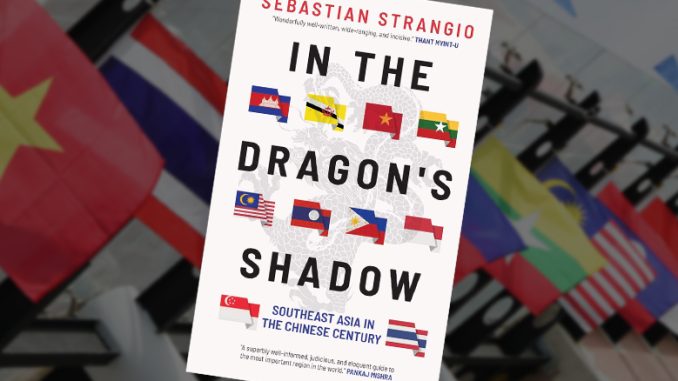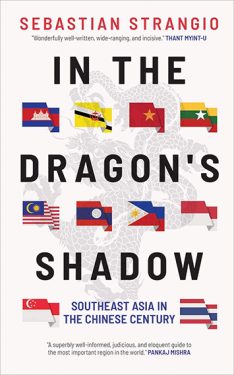
Title: In the Dragon’s Shadow: Southeast Asia in the Chinese Century
Author: Sebastian Strangio
Yale University Press, 2020
This is definitely a book that needed to be written, considering the enormous influence China has had on nearly every country in Southeast Asia, at least since the 1997 financial crisis and through the first two decades of the 20th century. In the Dragon’s Shadow provides a comprehensive view on Southeast Asia’s relations with China and the twists and turns of how the region has been influenced by the Chinese Mainland from the early-modern period to the present day. After the introduction, there are two outline chapters on Sino-Southeast Asian relations in a general region-wide sense. Then, chapter three to ten provide a more specific analysis on the PRC’s relations with every Southeast Asian nation, except Brunei and Timor-Leste. Vietnam, Thailand, Malaysia, Singapore, Indonesia, Myanmar and the Philippines each had their own chapters, while Laos and Cambodia were paired together in one chapter titled, “Phobos and Deimos.” 1 At the end, there is an ‘Afterword,’ which serves as sort of a conclusion and brings the discussion more up to date with issues relating to the COVID-19 pandemic.
It is over all a pleasant read, completed with interesting historical anecdotes that serve as the background for the contemporary narrative and analysis of China’s relationship with and influence upon each country featured in the main chapters. There is a neat overall parallel drawn between Admiral Zheng He’s voyages in the early-15th century and Xi Jinping’s Belt and Road Initiative (BRI), which was announced in 2013 and remain Xi’s flagship policy to the present day. There also appears to be a slight obsession with the Cold War narrative and a rather strong suggestion of a new Cold War situation rising across the South China Sea between the PRC and the US. This historical hint becomes particularly ominous in the ‘Afterword’ concluding chapter. Nonetheless, like all respectable journalistic pieces, In the Dragon’s Shadow is not overpowering with its concluding predictions, but instead provides a comfortable space for readers to decide for themselves whether to agree or disagree with the comprehensive overview of Sino-Southeast Asian relations presented throughout the book.
 A significant draw back of this piece, however, is that, for a book with a 2020 publication date, it appears slightly too confident about the present era still being ‘the Chinese Century.’ That is, especially considering the damages of COVID-19 and a whole year of massive protests in Hong Kong, which resulted in the even more destructive National Security Law. Although Hong Kong is not commonly considered as part of the Southeast Asian region, the fall of Hong Kong is a clear indication of a major faltering of Xi Jinping’s BRI ambitions. Moreover, as Hong Kong served as the main economic and financial gateway to China for most ethnic Chinese businesses in Southeast Asian countries throughout the Cold War and beyond, unrest in Hong Kong most definitely affects the ethnic Chinese trade network across the South China Sea and through most areas of Mainland Southeast Asia. The rise of the ‘Milk Tea Alliance’ among pro-democratic activists in Thailand, Hong Kong and Taiwan is but one major example that failed to appear In the Dragon’s Shadow. The mass evacuation of production bases from Shenzhen and other Chinese SEZs to Southeast Asia, especially Vietnam and Indonesia, is another related phenomenon that did not make it into the book.
A significant draw back of this piece, however, is that, for a book with a 2020 publication date, it appears slightly too confident about the present era still being ‘the Chinese Century.’ That is, especially considering the damages of COVID-19 and a whole year of massive protests in Hong Kong, which resulted in the even more destructive National Security Law. Although Hong Kong is not commonly considered as part of the Southeast Asian region, the fall of Hong Kong is a clear indication of a major faltering of Xi Jinping’s BRI ambitions. Moreover, as Hong Kong served as the main economic and financial gateway to China for most ethnic Chinese businesses in Southeast Asian countries throughout the Cold War and beyond, unrest in Hong Kong most definitely affects the ethnic Chinese trade network across the South China Sea and through most areas of Mainland Southeast Asia. The rise of the ‘Milk Tea Alliance’ among pro-democratic activists in Thailand, Hong Kong and Taiwan is but one major example that failed to appear In the Dragon’s Shadow. The mass evacuation of production bases from Shenzhen and other Chinese SEZs to Southeast Asia, especially Vietnam and Indonesia, is another related phenomenon that did not make it into the book.
The seeming obsession with the narrative of a new Cold War between China and the US is also problematic. This refuses Southeast Asia’s the agency that should be required for a region of independent and sovereign nation-states. In fact, the South China Sea was first claimed by China in 1947 by Chiang Kai-shek’s Republic of China. When Mao made the claims for the PRC in 1949, it was only because the PRC needed to claim all that was claimed by the ROC according to the One China Policy. The reason why the South China Sea was not contested over at that point was simply because most of Southeast Asia had not yet been fully decolonized and the PRC had not yet been accepted into the United Nations. The same body of water flared up as a major controversy in the 1990s precisely because China started to materialize its claim at a time when all states surrounding the South China Sea had become fully independent nation-states and recognized members of global and regional international organizations. Independent nation-states have much wider alternatives in terms of international relations than colonies or countries in the grip of explosive civil wars. Consequently, to analyze Southeast Asian nations and their relations with China in the 21st century according to the same paradigm as that of the colonial or Cold War eras is, to say the least, a controversial framework for a book.
All that having been stated, what good is a book on Sino-Southeast Asian relations these days if it does not stir up any controversy? This is definitely a book to start discussions and inspire further investigation of Southeast Asia in this problematic century, that might or might not be Chinese. Being the first of its kind, In the Dragon’s Shadow is already an almost insurmountable contribution to the field. Certainly a worthwhile read for the pandemic lockdown and a good preparation for making sense of the post-COVID-19 world from the Sino-Southeast Asian perspective.
Reviewed by Wasana Wongsurawat
Wasana Wongsurawat is associate professor of modern Chinese history at the Faculty of Arts, Chulalongkorn University. Specializing in the history of the overseas Chinese and the history of Sino-Southeast Asian relations, her first monograph, The Crown and the Capitalists: The Ethnic Chinese and the Founding of the Thai Nation, was published with the University of Washington Press in 2019.
Notes:
- Phobos and Deimos are the two moons of Mars. It is unclear whether the author is suggesting that Laos and Cambodia have become satellite states of China or if the history of both countries tend to put them into the position of satellite states of more dominant empires—Siam, Vietnam, US, USSR, PRC, etc. ↩
